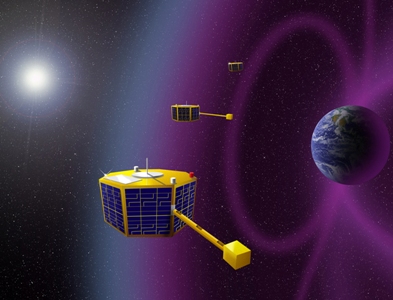
The Space Technology 5 mission will test crucial micro-satellite technologies.

Micro-sats with Macro-potential
By Patrick L. Barry
Future space telescopes might not consist of a single satellite such as Hubble, but a constellation of dozens or even hundreds of small satellites, or "micro-sats," operating in unison.
Such a swarm of little satellites could act as one enormous telescope with a mirror as large as the entire constellation, just as arrays of Earth-bound radio telescopes do. It could also last for a long time, because damage to one micro-sat wouldn't ruin the whole space telescope; the rest of the swarm could continue as if nothing had happened.
And that's just one example of the cool things that micro-sats could do. Plus, micro-sats are simply smaller and lighter than normal satellites, so they're much cheaper to launch into space.
In February, NASA plans to launch its first experimental micro-sat mission, called Space Technology 5. As part of the New Millennium Program, ST5 will test out the crucial technologies needed for micro-sats-such as miniature thrust and guidance systems-so that future missions can use those technologies dependably.
Measuring only 53 centimeters (20 inches) across and weighing a mere 25 kilograms (55 pounds), each of the three micro-sats for ST5 resembles a small television in size and weight. Normal satellites can be as large and heavy as a school bus.
"ST5 will also gather scientific data, helping scientists explore Earth's magnetic field and space weather," says James Slavin, Project Scientist for ST5.
Slavin suggests some other potential uses for micro-sats:
A cluster of micro-sats between the Earth and the Sun-spread out in space like little sensor buoys floating in the ocean-could sample incoming waves of high-speed particles from an erupting solar flare, thus giving scientists hours of warning of the threat posed to city power grids and communications satellites.
Or perhaps a string of micro-sats, flying single file in low-Earth orbit, could take a series of snapshots of violent thunderstorms as each micro-sat in the "train" passes over the storm. This technology would combine the continuous large-scale storm monitoring of geosynchronous weather satellites-which orbit far from the Earth at about 36,000 kilometers' altitude-with the up-close, highly detailed view of satellites only 400 kilometers overhead.
If ST5 is successful, these little satellites could end up playing a big role in future exploration.
The ST5 Web site at nmp.jpl.nasa.gov/st5 has the details. Kids can have fun with ST5 at spaceplace.nasa.gov, by just typing ST5 in the site's Find It field.

The Space Technology 5 mission will test crucial micro-satellite technologies.
This article was provided by the Jet Propulsion Laboratory, California Institute of Technology, under a contract with the National Aeronautics and Space Administration.
All content is the responsibility of LUNAR.
If you have comments or suggestions regarding these web pages,
please contact the 
Copyright © 1992 - 2025 LUNAR